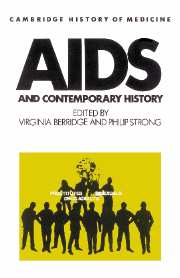Book contents
- Frontmatter
- Contents
- Notes on contributors
- Acknowledgements
- Introduction: AIDS and contemporary history
- I The pre-history of AIDS
- 1 AIDS and the regulation of sexuality
- 2 Public health doctors and AIDS as a public health issue
- 3 Politics and policy: historical perspectives on screening
- 4 Testing for a sexually transmissible disease, 1907–1970: the history of the Wassermann reaction
- 5 The politics of international co-ordination to combat sexually transmitted diseases, 1900–1980s
- 6 Hepatitis B as a model (and anti-model) for AIDS
- II AIDS as history
- Appendix AIDS: the archive potential
- Index
- Cambridge history of medicine
1 - AIDS and the regulation of sexuality
Published online by Cambridge University Press: 14 October 2009
- Frontmatter
- Contents
- Notes on contributors
- Acknowledgements
- Introduction: AIDS and contemporary history
- I The pre-history of AIDS
- 1 AIDS and the regulation of sexuality
- 2 Public health doctors and AIDS as a public health issue
- 3 Politics and policy: historical perspectives on screening
- 4 Testing for a sexually transmissible disease, 1907–1970: the history of the Wassermann reaction
- 5 The politics of international co-ordination to combat sexually transmitted diseases, 1900–1980s
- 6 Hepatitis B as a model (and anti-model) for AIDS
- II AIDS as history
- Appendix AIDS: the archive potential
- Index
- Cambridge history of medicine
Summary
Introduction
The HIV/AIDS epidemic is framed, if not burdened, by many histories. There are histories of past epidemics and diseases, including sexually transmitted diseases; histories of scientific investigation, and of medicine and social hygiene; histories of the various groups affected by HIV and AIDS: of homosexuals, of drug users, of the poor and racially disadvantaged in the urban centres of western nations, and of the poor and exploited in the developing world; and there are histories of social policy and of welfare policies, or of their absence, which can help us to understand the various phases of the political and governmental response to HIV and AIDS. AIDS is already a deeply historicised phenomenon.
But at the centre of any attempt to understand the response to the epidemic in the west must be the history (or rather histories) of sexuality. At the most basic level this is because sexual intercourse is one of the most efficient means of transmission of the virus, and changing patterns of sexual interaction helps explain its rapid spread from the late 1970s. There is, however, a more profound reason why we need to situate HIV and AIDS in a history of sexuality. AIDS was identified at a particular moment in that history, when values and behaviour were in a period of unprecedented flux, and when sex-related issues came close to the top of the political agenda.
- Type
- Chapter
- Information
- AIDS and Contemporary History , pp. 17 - 36Publisher: Cambridge University PressPrint publication year: 1993
- 3
- Cited by



